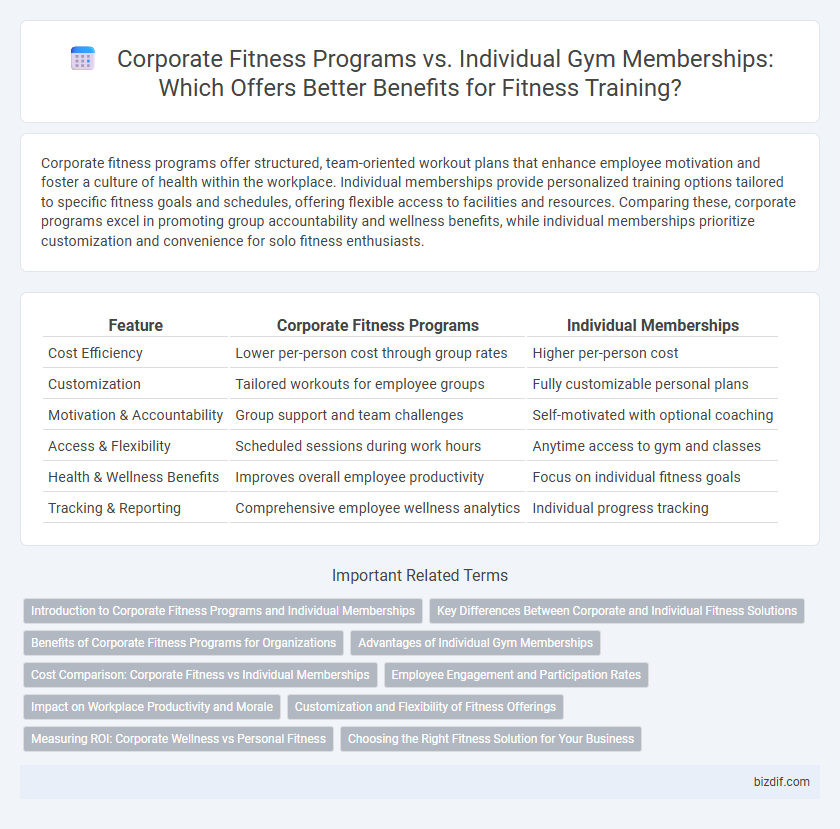Corporate fitness programs offer structured, team-oriented workout plans that enhance employee motivation and foster a culture of health within the workplace. Individual memberships provide personalized training options tailored to specific fitness goals and schedules, offering flexible access to facilities and resources. Comparing these, corporate programs excel in promoting group accountability and wellness benefits, while individual memberships prioritize customization and convenience for solo fitness enthusiasts.
Table of Comparison
| Feature | Corporate Fitness Programs | Individual Memberships |
|---|---|---|
| Cost Efficiency | Lower per-person cost through group rates | Higher per-person cost |
| Customization | Tailored workouts for employee groups | Fully customizable personal plans |
| Motivation & Accountability | Group support and team challenges | Self-motivated with optional coaching |
| Access & Flexibility | Scheduled sessions during work hours | Anytime access to gym and classes |
| Health & Wellness Benefits | Improves overall employee productivity | Focus on individual fitness goals |
| Tracking & Reporting | Comprehensive employee wellness analytics | Individual progress tracking |
Introduction to Corporate Fitness Programs and Individual Memberships
Corporate fitness programs provide tailored wellness solutions that enhance employee health, boost productivity, and reduce healthcare costs by offering group classes, personalized coaching, and on-site facilities. Individual memberships grant access to gym equipment, fitness classes, and personal training, allowing for flexible workout schedules and customized fitness goals. Both options promote physical well-being but differ in structure, scale, and organizational support.
Key Differences Between Corporate and Individual Fitness Solutions
Corporate fitness programs offer tailored group workouts, wellness challenges, and on-site facilities designed to improve employee health and boost workplace productivity, while individual memberships provide personalized fitness plans, flexible scheduling, and access to diverse gym amenities. Corporate solutions often include health assessments, team-building activities, and corporate discounts, which are typically not available with individual memberships. Costs for corporate programs are usually negotiated based on employee volume, whereas individual memberships require standard monthly or annual fees paid by the member.
Benefits of Corporate Fitness Programs for Organizations
Corporate fitness programs enhance employee productivity and reduce healthcare costs by promoting regular physical activity and wellness. Organizations benefit from improved employee morale, decreased absenteeism, and stronger team collaboration through structured group fitness initiatives. Investing in corporate wellness fosters a healthier workforce, leading to higher retention rates and overall organizational performance.
Advantages of Individual Gym Memberships
Individual gym memberships offer personalized workout plans tailored to specific fitness goals, enhancing effectiveness and motivation. Members benefit from flexible scheduling and access to diverse equipment and classes, accommodating varying preferences and routines. This autonomy supports consistent progress and fosters a stronger commitment to long-term health and wellness.
Cost Comparison: Corporate Fitness vs Individual Memberships
Corporate fitness programs often provide cost-effective solutions by distributing expenses across numerous employees, resulting in lower per-person rates compared to individual memberships. Bulk service agreements typically include access to group classes, personalized coaching, and wellness resources, reducing overall expenditure while enhancing employee health. Individual memberships usually incur higher monthly fees with fewer bundled benefits, making corporate programs more economical for organizations seeking scalable fitness solutions.
Employee Engagement and Participation Rates
Corporate fitness programs significantly boost employee engagement by fostering teamwork and creating a culture of wellness within the workplace, resulting in higher participation rates compared to individual memberships. Employees enrolled in corporate programs are 30% more likely to consistently attend fitness sessions, driven by employer incentives and the convenience of on-site facilities. Individual memberships often lack these motivational structures, leading to lower sustained participation and engagement over time.
Impact on Workplace Productivity and Morale
Corporate fitness programs boost workplace productivity by fostering team cohesion and reducing absenteeism through group motivation and shared wellness goals. These programs enhance employee morale by creating a supportive environment that encourages healthy habits and reduces stress levels. In contrast, individual memberships offer personalized fitness benefits but may lack the collective engagement that drives widespread organizational performance improvements.
Customization and Flexibility of Fitness Offerings
Corporate fitness programs offer tailored group workouts and flexible scheduling designed to improve employee health and boost workplace productivity, often including personalized coaching and wellness challenges. Individual memberships provide customizable plans focused on personal goals, allowing users to select specific classes, training sessions, and gym access times that fit their unique lifestyle. Both options prioritize customization, but corporate programs emphasize team-oriented flexibility while individual memberships cater to solo fitness preferences.
Measuring ROI: Corporate Wellness vs Personal Fitness
Measuring ROI in corporate fitness programs involves tracking metrics such as reduced absenteeism, increased employee productivity, and lower healthcare costs, which directly impact organizational performance. Individual memberships focus on personal health improvements like weight loss, strength gains, and enhanced mental well-being, which can be quantified through personal progress assessments and fitness benchmarks. Corporate wellness initiatives offer broader data through aggregated employee health trends, while personal fitness ROI is measured through individual goal attainment and satisfaction.
Choosing the Right Fitness Solution for Your Business
Corporate fitness programs enhance employee wellness by offering tailored group workouts, on-site trainers, and flexible scheduling, boosting productivity and reducing absenteeism. Individual memberships provide personalized training and access to diverse facilities, ideal for businesses with varied fitness preferences among employees. Evaluating company size, employee fitness goals, and budget helps determine whether corporate programs or individual memberships deliver the best ROI and engagement.
Corporate Fitness Programs vs Individual Memberships Infographic

 bizdif.com
bizdif.com